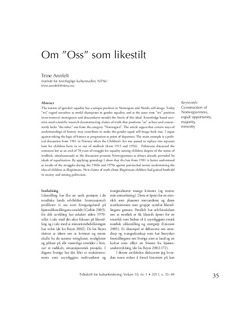| dc.contributor.author | Annfelt, Trine | |
| dc.date.accessioned | 2019-08-29T11:12:09Z | |
| dc.date.available | 2019-08-29T11:12:09Z | |
| dc.date.created | 2011-06-21T10:28:39Z | |
| dc.date.issued | 2011 | |
| dc.identifier.citation | Tidsskrift for kulturforskning. 2011, 10 (1), 35-49. | nb_NO |
| dc.identifier.issn | 1502-7473 | |
| dc.identifier.uri | http://hdl.handle.net/11250/2611585 | |
| dc.description.abstract | The notion of (gender) equality has a unique position in Norwegian and Nordic self-image. Today âweâ regard ourselves as world champions in gender equality, and at the same time âweâ position (non western) immigrants and descendants outside the limits of this ideal. Knowledge based societies need scientific research deconstructing claims of truth that positions âusâ as best and concurrently locks âthe otherâ out from the category âNorwegianâ. The article argues that certain ways of understandings of history may contribute to make the gender equal self-image look true. I argue against taking the logic of history as progression as point of departure. The main example is a political discussion from 1981 in Norway when the Childrenâs Act was passed to replace two separate laws for children born in or out of wedlock (from 1915 and 1956). Â Politicians discussed the common law as an end of 70 years of struggle for equality among children despite of the status of wedlock, simultaneously as the discussion presents Norwegianness as always already pervaded by ideals of equalization. By applying genealogy I show that the law from 1981 is better understood as results of the struggles during the 1960s and 1970s against patriarchal norms undermining the idea of children as illegitimate. New claims of truth about illegitimate children had gained foothold in society and among politicians. | nb_NO |
| dc.language.iso | mis | nb_NO |
| dc.publisher | Novus forlag | nb_NO |
| dc.rights | Navngivelse-DelPåSammeVilkår 4.0 Internasjonal | * |
| dc.rights.uri | http://creativecommons.org/licenses/by-sa/4.0/deed.no | * |
| dc.title | Om "oss" som likestilt : | nb_NO |
| dc.type | Journal article | nb_NO |
| dc.type | Peer reviewed | nb_NO |
| dc.description.version | publishedVersion | nb_NO |
| dc.source.pagenumber | 35-49 | nb_NO |
| dc.source.volume | 10 | nb_NO |
| dc.source.journal | Tidsskrift for kulturforskning | nb_NO |
| dc.source.issue | 1 | nb_NO |
| dc.identifier.cristin | 826380 | |
| dc.description.localcode | Open Access CC-BY-SA | nb_NO |
| cristin.unitcode | 194,62,40,0 | |
| cristin.unitname | Institutt for tverrfaglige kulturstudier | |
| cristin.ispublished | true | |
| cristin.fulltext | original | |
| cristin.qualitycode | 1 | |

